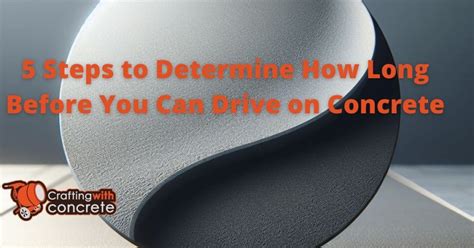How Long Before You Can Drive On Fresh Concrete
Ronan Farrow
Apr 05, 2025 · 3 min read

Table of Contents
How Long Before You Can Drive on Fresh Concrete?
So, you've got a brand new driveway, patio, or even a whole new concrete foundation. Looks fantastic, right? But the burning question remains: how long before you can drive on fresh concrete? The answer, unfortunately, isn't a simple one-size-fits-all. It depends on several factors, and getting it wrong can mean costly repairs. Let's dive in!
Factors Affecting Concrete Curing Time
Several crucial factors influence how long concrete needs to cure before it can support vehicular traffic. Ignoring these can lead to cracking, pitting, and other damage.
1. Concrete Mix Design
The specific mix design, including the water-cement ratio, significantly impacts curing time. A higher water-cement ratio generally means a longer curing period. Stronger concrete mixes will naturally take longer to cure.
2. Weather Conditions
Temperature and humidity play a massive role. Hot, dry weather accelerates evaporation, potentially leading to rapid surface drying but weak interior strength. Conversely, cold, wet weather slows down the curing process. Extreme temperatures (both hot and cold) can cause problems.
3. Concrete Thickness
Thicker concrete slabs require longer curing times to achieve sufficient strength throughout. Think of it like a cake – a thicker cake takes longer to bake completely.
4. Type of Concrete
Different types of concrete, like high-strength concrete or specialized mixes, will have varying curing times. Always consult the concrete supplier's recommendations.
5. Additives
Concrete admixtures, such as accelerators or retarders, can significantly impact the curing process. Accelerators speed up the process, while retarders slow it down. These are often used to adjust the curing time based on specific project needs and weather conditions.
General Guidelines and Safe Practices
While there's no magic number, here are some general guidelines:
- Minimum: Most contractors recommend waiting at least 7 days before allowing any light vehicle traffic on fresh concrete. This is a bare minimum and assumes favorable weather conditions.
- Ideal: For heavier vehicles or sustained traffic, a minimum of 28 days is highly recommended. This allows the concrete to reach its full compressive strength.
- Always err on the caution: It's always better to wait too long than to risk damaging the concrete too soon. The cost of repair will far outweigh the inconvenience of waiting.
Signs of Sufficient Curing
Before driving on the concrete, check for these signs:
- Firm surface: The surface should feel firm and solid underfoot, with no noticeable give.
- No dusting: There should be no visible dust or powder when you rub your hand across the surface.
- Consistent color: The concrete should have a relatively uniform color, indicating even curing.
Protecting Your Investment
Taking the necessary precautions is crucial to ensure the longevity of your concrete investment. Remember, patience is key. Waiting the recommended time allows the concrete to cure properly, preventing costly repairs and ensuring the long-term durability of your project.
By carefully considering these factors and following the best practices outlined above, you'll significantly improve the chances of a beautiful, long-lasting concrete surface. Patience truly is a virtue when it comes to concrete!
Featured Posts
Also read the following articles
| Article Title | Date |
|---|---|
| How Long After Botox Can I Tan | Apr 05, 2025 |
| How Long Can Toxic Release Last | Apr 05, 2025 |
| How Long Can You Drive With A Bad Tie Rod | Apr 05, 2025 |
| How Long Can Plecos Live | Apr 05, 2025 |
| How Long Can A Generac Run Continuously | Apr 05, 2025 |
Latest Posts
-
How Long Does 6 Holes Of Golf Take
Apr 05, 2025
-
How Long Does 5200 Take To Cure
Apr 05, 2025
-
How Long Does 50 Ml Of Cologne Last
Apr 05, 2025
-
How Long Does 5 Gallons Of Propane Last
Apr 05, 2025
-
How Long Does 4 Tire Change Take
Apr 05, 2025
Thank you for visiting our website which covers about How Long Before You Can Drive On Fresh Concrete . We hope the information provided has been useful to you. Feel free to contact us if you have any questions or need further assistance. See you next time and don't miss to bookmark.
